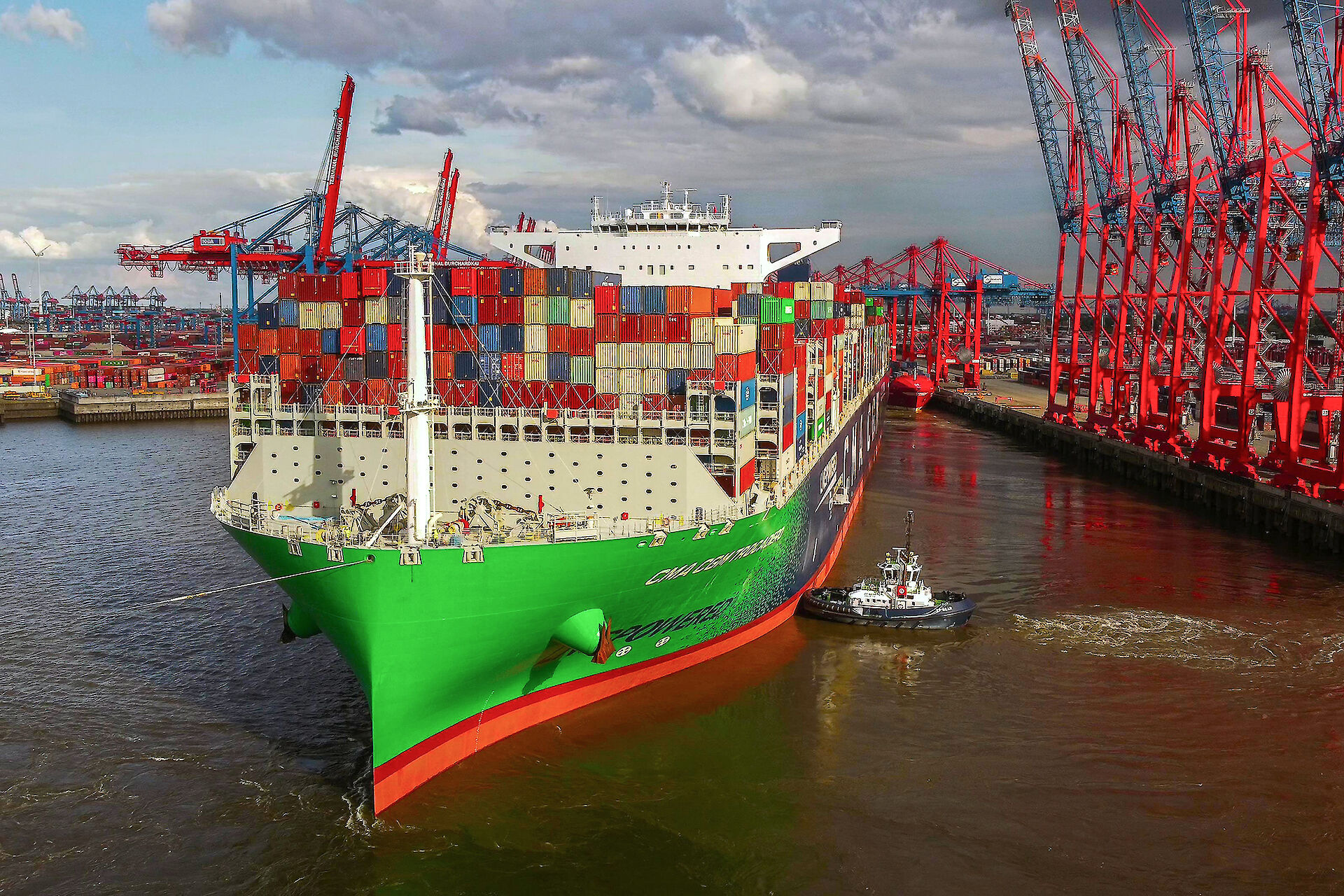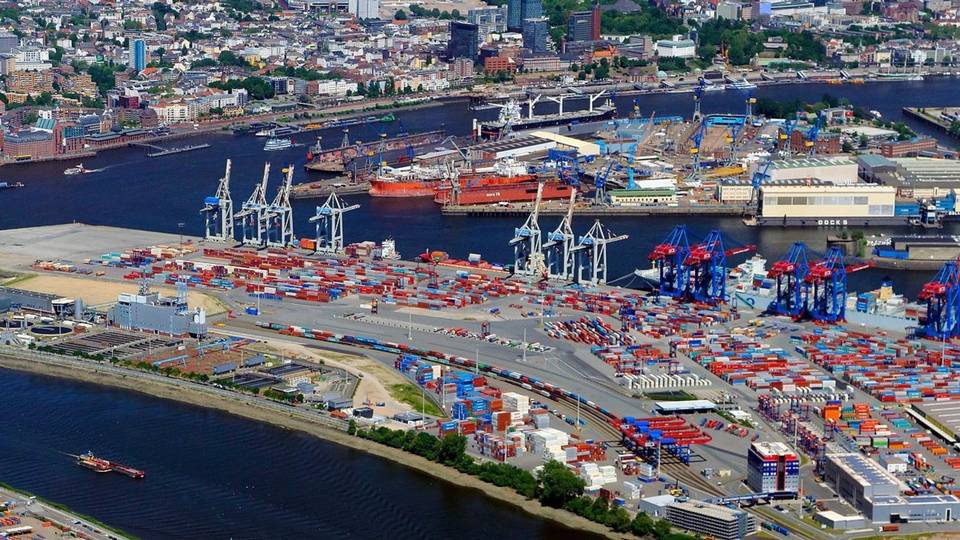The overall trend in seaborne cargo throughput in the Port of Hamburg in the first half of 2021 was positive.
General and bulk cargo throughput picked up markedly in the second quarter. At 63.5 million tons, total seaborne cargo throughput was up by 3.8 percent. Container handling at 4.3 million TEU – 20-ft standard containers – was 5.5 percent up.
After a modest start in the first two months, March and the second quarter brought a distinct surge in container handling. Totalling 19.3 million tons, throughput of bulk goods remained on an upward curve, being ahead by 3.3 percent.
Especially in the first few months of the first half of 2021, the persisting worldwide repercussions of the Corona pandemic were still determining the throughput trend in the Port of Hamburg. “We find that throughput in the Port of Hamburg has developed positively, embarking on a recovery process. Yet it was not yet possible to fully recover the throughput downturn caused by the repercussions of the pandemic in Hamburg , among other ports. Growing import and exports, heavy consumer demand, and the Port of Hamburg’s immense range of liner services, are bringing us on to a stable growth curve,” explained Axel Mattern, Joint CEO of Port of Hamburg Marketing – HHM.
At the Port of Hamburg online press conference organized by HHM, Axel Mattern was especially gratified by the record figure for railborne container transport. At 1.4 million TEU, during the first six months of the year the Port of Hamburg Railway network achieved a fresh record. “That’s an 11.3 percent advance, underlining Hamburg’s position as Europe’s top rail port,” added Mattern.
The first stage of the fairway adjustment in the Elbe also made a positive impact. Jens Meier, CEO of HPA – Hamburg Port Authority, pointed out that clearance for this had made movement and passing considerably simpler for large vessels. “Even for the extremely large containerships of the Megamax class, offering slot capacities of between 18,000 and 24,000 TEU, the Port of Hamburg is now more readily accessible. In the first half of 2021 alone, 107 of these Megamax containerships called Hamburg. That’s a 24.4 percent increase, making clear that the fairway adjustment is a successful project for the port, shipping, and the economy,” explained Meier.
Seaborne cargo throughput in the Port of Hamburg in the first half of 2021
In the first six months of the year, 63.5 million tons of seaborne cargo were loaded or discharged at terminals in the Universal Port of Hamburg, or 3.8 percent more than in the previous year. At 44.2 million tons, general cargo throughput was up by 4.0 percent. The trend was also distinctly upwards for container handling in Hamburg at 4.3 million TEU – 20-ft standard containers, a 5.5 percent increase on the previous year. Ahead by 6.1 percent, export container handling at 2.1 million TEU rose more strongly than for imports, 5.0 percent up at 2.2 million TEU. Of special interest for the port’s added value, total throughput of loaded containers, which rose 6.9 percent to 3.8 million TEU, was a very strong feature. At 464,000 TEU, empty box throughput was 4.5 percent lower than in the same period of the previous year.
Positive throughput trend for Port of Hamburgs after reverses caused by Corona
Bulk cargo throughput at 19.3 million tons achieved growth of 3.3 percent. Within this segment, grab cargo throughput was outstanding, gaining 20 percent to 10.5 million tons. Ahead by 26.3 percent, ore imports were the main reason for this. Throughput of suction and liquid cargoes at 3.2 and 5.6 million tons, respectively, was lower than in the same period of the previous year, being down by 22.6 and 3.3 percent.
A quick glance at returns from the container trades also reveals a positive picture. “Leaving aside Australia/Pacific, the other trades with America, Asia and Africa all reveal a favourable throughput trend. Among the Europe trades, however, the trend was only positive on transhipment throughput with the Scandinavian countries, up by 6.4 percent. Overall, however, the total for Europe trades was slightly ahead, being half a percent up,” said Mattern.
Differing trends for Top Ten partners for seaborne container handling
Container handling trends for the Port of Hamburg’s Top Ten trading partners varied during the first six months of 2021. At 1.3 million TEU, seaborne container handling with China, Hamburg’s leading trading partner by a wide margin, achieved a 14.2 percent advance. Despite the at times massive constraints for cargo handling operators in some Chinese ports, nearly all of them reported first-half growth in container handling. In the first six months, 22.9 million TEU were handled there, an advance of 14.9 percent.
Remaining Hamburg’s No. 2 partner, with 303,000 TEU – up 5.3 percent – the USA also remained on a growth curve. During the first six months, other Top Ten countries where the container handling trend was positive were: Sweden – up 5.3 percent, South Korea – up 2.4 percent, Poland – up 14.4 percent, Brazil – up 16.1 percent and Denmark – up 6.4 percent. During the first half, these satisfactory developments in seaborne container handling sufficed to offset downturns with other countries. “A distinct upward trend is evident among Hamburg’s Top Ten trading partners for seaborne container transport. Seven of them already report growth. Among the three with downturns, we are seeing stabilization and slight recovery. Overall, for the Universal Port of Hamburg we assume that growth in seaborne cargo throughput will also continue in the second half,” stressed Mattern.
Increased security essential for global supply chains
Despite the positive trend in the Port of Hamburg’s throughput totals, the logistics challenges for worldwide transport chains remain immense. The problems arise from lack of transport capacities, uncertainties in connection with the further course of the pandemic, and other occurrences such as the recent grounding of a containership in the Suez Canal. Repercussions then emerge at land-sea transport interfaces, and consequently at Germany’s largest seaport. “Along with port operators, the Hamburg Port Authority and our port customers, so far we have managed to maintain 24/7 operation in the port. We are all working on optimizing logistics processes in the port as well as in pre- and post-voyage traffic. Our goal is to handle worldwide goods flows in the Port of Hamburg smoothly and efficiently,” emphasized Axel Mattern. During his address to the Port of Hamburg’s online press conference, Knut Alicke, a partner with McKinsey & Company, stressed how vulnerable global supply chains have become. That is not simply a matter of delays to many ships that can last for weeks, but also digital security and not least, structural influences such as climate change, or crisis situations in specific states. To be capable of countering such threats, continual analysis is essential. Only those who grasp a new situation rapidly will be capable of adjusting to it, stressed Alicke. Since March 2020, many companies have reacted by intensifying their own supply chain risk management. Only essential resilience of this kind at companies will enable global supply chains to be kept flowing.
Container transport by rail sets new record
In the first six months, 1.4 million TEU were transported on the Port of Hamburg Railway network, an increase of 11.3 percent. “We are delighted by this record. Despite sometimes difficult conditions, an increase in railborne container transport to and from the Port of Hamburg proved attainable. Our pleasure was also enhanced by the excellent figure of 23.7 million tons – up 4.4 percent – for all freight transported by rail,” said HPA chief Jens Meier. Port of Hamburg Railway daily handles over 200 freight trains, with more than 5,500 railcars moving along its high-performance network of about 300 kilometres. In Meier’s opinion, even during the corona pandemic the system has proved reliable. “We regret that on account of the large number of late ship arrivals, during the first half delays also occurred in rail handling in the Port of Hamburg. Yet terminal and rail operators, along with the many inland terminals, made tremendous efforts to avoid bottlenecks in handling,” added Meier. Among other factors, it proved possible to further boost utilization of container block trains. In the Port of Hamburg’s seaport-hinterland traffic, still better use of track and the equipment deployed boosted rail’s share of modal split. With a 50.7 percent share, in Germany’s largest seaport rail was already the top carrier for landside transport last year.
In addition to the favourable trend on railborne seaport-hinterland services, the first half of 2021 also brought new container block train services between Hamburg and China along the New Silk Road. Among the sources of additional continental container transport were the new block train services between Hamburg and the Chinese cities of Shijiazhuang in Hebei, and Wuhei in the province of Gansu. Already existing links with Suzhou and Xi’an were expanded by additional providers. Even the old Silk Road commenced in the ancient Chinese imperial city of Xi’an. Hamburg has the most rail services with Xi’an and freight from there reached terminals in the port on virtually every weekday. Next for number of services is Zhengzhou, capital of Henan province. Since the beginning of the year merchandise from Hanoi in Vietnam has regularly reached Hamburg via this route.
Outlook for 2021
For 2021, the Port of Hamburg’s marketing organization anticipates an upward trend in seaborne cargo throughput. With the stabilization of liner service sailings plus new services, and the situation also improving worldwide, throughput figures of around 130 million tons and 8.7 million TEU should be attainable.
Source: Hellenic Shipping News





